|
Useful Basin Modeling Interactive Petroleum System Tools |
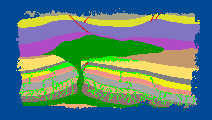
|
| HOME | PRODUCTS | SUPPORT | UTILS | LINKS | ABOUT |
|
|
Practical Basin Modeling
Traditional basin models are under-constrained. Most of the input parameters are unknown while much emphasis is still put on increasing complexity of the model. At ZetaWare, we believe in developing and using interactive and probabilistic tools with the emphasis on geological data. Instead of investigating in excruciating detail all the processes that goes on in a basin (without much data), we focus on problems and answers that help exploration teams make decision.
The following example shows our approach in migration modeling. By interactively matching existing fields with a minimum geological model based on seismic data, the migration model is calibrated to the local geology, allowing the prediction of undiscovered accumulations. More details of this example here ...
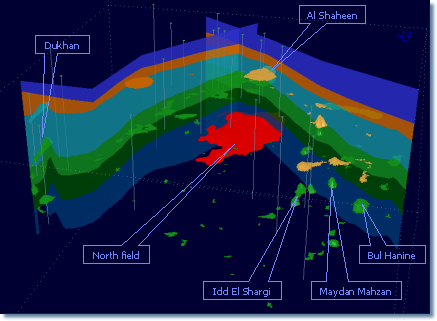
Predicting Heat Flow Away From Wells
Traditional basin models use given heat flow as the boundary condition, either the user has to assume that heat flow is constant over the area (which we know is not valid) or we have to have a lot of heat flow data (which is not practical). Genesis uses a constant temperature boundary condition at base of lithosphere. The advantage is that once the model is calibrated with temperature data at the well location, we can then use the same boundary condition varying only the geology. The heat flow variation away from wells and in the geological past are automatically determined as a function of the geology we are varying:
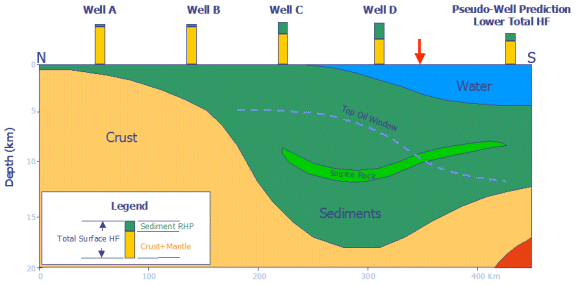
This example shows how simply using heat flow calibrated from wells A-D, can provide inaccurate and costly results for evaluating deep water plays. The shallow water wells all provided fairly similar heat flows, which if applied to the deep water region, would cause incorrect prediction of source rock maturity. This may lead to the wrong prospects being drilled while economic reservoirs not drilled.
Improved Rifting Heat Flow Model
The typical basin model uses McKenzie's lithosphere stretching model to describe heat flow through time in rift basins. The implementation usually causes the heat flow to be unrealistically too high at the end of rifting. Such model over predicts source rock maturity and incorrectly puts timing of hydrocarbon generation before trap formation. The use of Genesis allows for consistency with observed data and provides more appropriate timing for generation allowing for better exploration risk characterization.
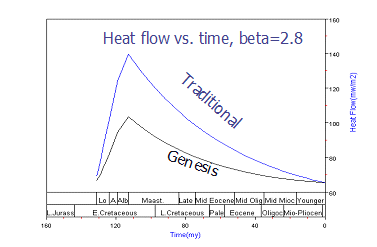
This Campos basin (Brazil) example shows the heat flow history modeled using the traditional McKenzie model compared that from Genesis. For a stretching factor of 2.8, the traditional approach predicts heat flow to be 140 mW/m2 at Cretaceous time, while Genesis's estimates was less than 100 mW/m2.
Interactive migration and charge analysis
With Trinity ,we have made migration modeling a job for the geologist instead of the specialist. Simply clicking any spot on the structure map with the petroleum syringe tool allows you to see the fill and spill migration pathways. The magic wand instantly determines the trap size, volume and the fetch area for the prospect.

Charge Volume Prediction
In addition to the probabilistic approach , we also believe that a simple but empirically calibrated model will be more useful than a more theoretically sophisticated model without much data support. For example, after charge volumes from the fetch area for each prospect and known fields are calculated (left), the predicted charge volume vs. in place reserve plot (right) for several existing fields from the Qatar area gives confidence to predicting reserves for prospects. Migration efficiency may be esimated based on the difference.
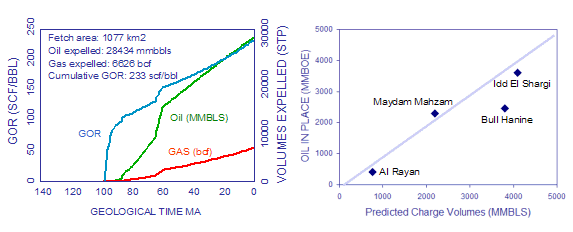
More examples to come ... ...
References:
- He, Z, and T. Berkman, 1999, Interactive Charge Modeling of the Qatar Arch Petroleum Systems; Multi-Dimensional Basin Modeling MAY 9-13, 1999, COLORADO SPRINGS, COLORADO.
- Crews, S.G., and Bergman, S.C., 2000, The use of geodynamic and kinematic models to construct heat flow histories for rift basin thermal maturity modeling (abst.): 7th Latin-American Congress on Organic Geochemistry (ALAGO), Foz do Iguaçu, Brazil, October, 2000.
Copyright ©2004, ZetaWare, Inc. All rights reserved | Terms of use